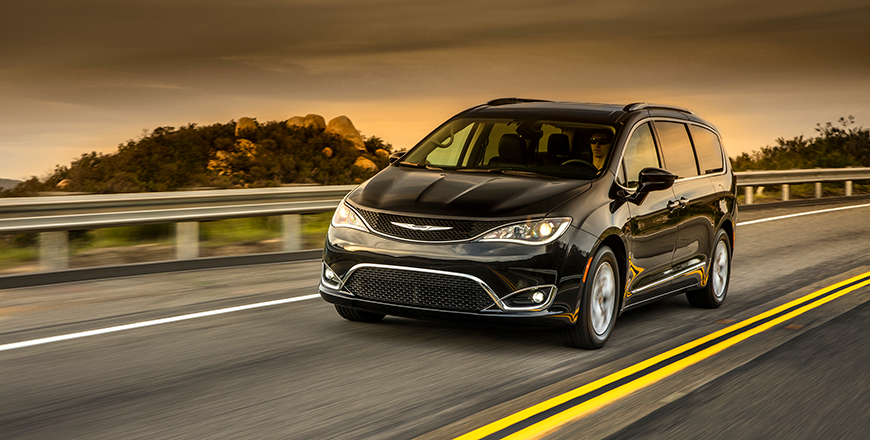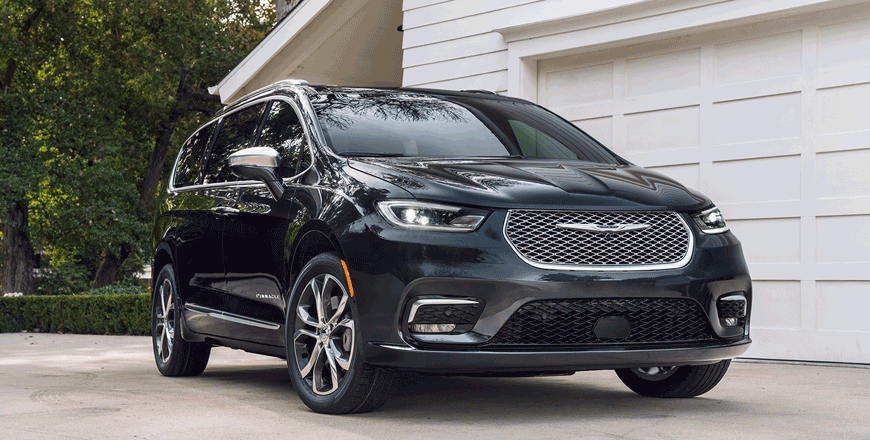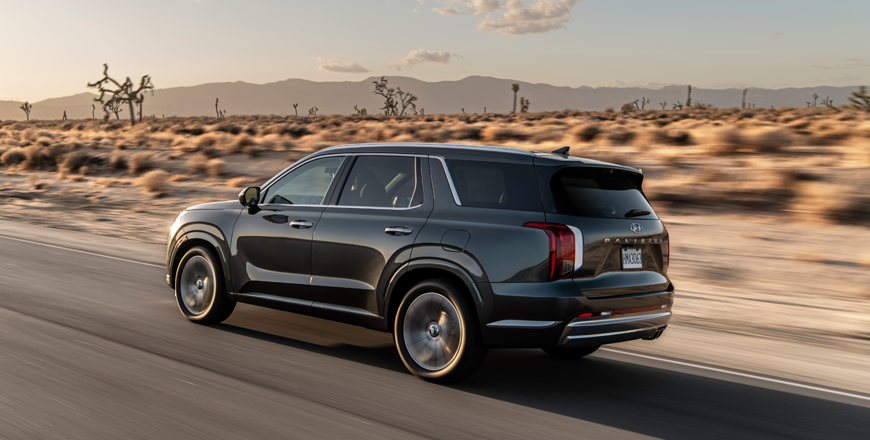You are here
Chrysler Pacifica: A modern take on the mini-van
By Ghaith Madadha - May 04,2020 - Last updated at May 04,2020

Photo courtesy of Chrysler
The headlining brand of the US wing of the Italian-American Fiat Chrysler Group (FCA) and one of Detroit’s traditional ‘big three’, Chrysler has in recent years been somewhat eclipsed by its Dodge and Jeep subsidiaries in popularity and product diversity. But despite the more recent demise of its more compact offerings, Chrysler has instead honed down its current model range to concentrate on what it does best, namely the large luxurious and statuesque 300 saloon and Pacifica mini-van, MPV or people carrier.
Dedicated to and excelling in the declining mini-van segment even as similar vehicles are dropped by other manufacturers, Chrysler has become a go-to choice for much of what remains of the MPV-buying public in the wake of ever-expanding crossover and SUV segments. Introduced in 2016 as a modern interpretation of the traditional large family mini-van, the Pacifica succeeded both Chrysler’s Grand Voyager and Town and Country people carriers, with a sleek bullet-like shape similar to the former, but much different to the latter’s boxy form.
Swept style
Sharper and sleeker than its predecessors, the Pacifica features a fashionably higher waistline and smaller glasshouse than either, with more detailed surfacing and more prominent and flowing lines and creases across the flanks and along the bonnet. Swept back, the Pacifica features a swooping front fascia combo, with strongly browed headlights and slim grille. Dramatic either with blacked out or chrome lined accents and darker colours, the Pacifica’s wedge-like shape, descending roofline and angled rear pillar lend it a sense of forward momentum.
Built on a front-wheel-drive platform fed through a slick-shifting 9-speed automatic gearbox to best utilize its output for economy, performance, flexibility and refinement, the Pacifica is powered by FCA’s sweet, eager and relatively high-revving naturally-aspirated 3.6-litre V6 Pentastar engine. A welcome antidote to ever-more popular small turbocharged engines with more sudden bursts of mid-range heroics, the Pentastar’s delivery is seamlessly smooth and progressive as it urgently builds momentum through revs and unlocks its full 287BHP at 6,000rpm and 262lb/ft torque at 4,000rpm.
Progressive and perky
Responsive from standstill and with a quick jerk from the steering wheel as its front 235/60R18 tyres briefly chirp and find traction under full throttle launch, the Pacifica briskly carries its not insubstantial 1,964kg mass through 0-100km/h in 7.4-seconds. Best when hunting its 6,400rpm rev limit, the Pacifica nevertheless matches its eager top-end with good low-end response and versatile mid-range delivery when cruising. Returning relatively moderate 12l/100km city and 8.4l/100km highway economy, the Pentastar’s eager-revving rewards make less economical driving all too tempting.
Precise in its throttle response and progressive in delivery, the Pacifica allows power and torque modulation to maintain traction and grip through corners. With its revvy and progressive engine and its car-like unibody construction and ground clearance, the Pacifica drives in a sportier and more agile manner than anticipated. Granted that it is not a sporty vehicle outright, but for a vast three row mini-van it handles pretty well, and is tidy and eager into corners with reasonably quick and direct steering.
Unexpectedly eager
Unexpectedly eager, the Pacifica feels more agile into corners than out of corners, where its length becomes quite apparent. That it is not perky or playful through corners is, however, not a bad thing for a mini-van, but is entirely expected and means that it delivers reassuringly high rear grip levels. If pushed to its dynamic limits, the Pacifica’s instinct would be for slight understeer, but that is not how people tend to drive MPVs. Meanwhile, body roll is also reasonably well controlled through corners.
A comfortable drive in town and on highway, the Pacifica takes most road imperfections in its stride and remains smooth, stable and reassuringly refined at speed. Seated high in its relatively low cabin, one has excellent front visibility over its low bonnet, while reversing sensors and cameras, and a comparatively tight 12.1-metre turning circle make it easy to manoeuvre for such a long vehicle. Seating is meanwhile comfortable and well-adjustable in front and there is plenty of room for second and third row passengers.
Classy and cavernous
Classy, comfortable and conveniently laid out inside, the Pacifica has an accessibly luxurious and warm ambiance inside without seeming too ‘precious’ or overdone. Featuring plenty of storage spaces and useful features for front and rear passengers, the Pacifica can be specified as an 8- or 9-seater with either middle row captain’s or bench seats. Practical with its low lift-over and step in height, wide swing angle front doors and large sliding rear doors, the Pacifica also features huge cargo configurations, including van-like volume with rear seats folded flat.
Well-equipped and practical, the Pacifica features easy to fold forward middle seats for rear row access and electric seat folding controls accessible from the cargo area. Its intuitive Uconnect infotainment system can be supplemented with an optional dual 10-inch rear touchscreen family entertainment system. Meanwhile, safety equipment is similarly generous with all versions featuring child seat latches and blindspot and rear crosspath warning systems, while top spec Limited models also receive a 360° surround view camera, brake assistance, advanced collision warning and lane departure systems.
Specifications
- Engine: 3.6-litre, transverse V6-cylinders
- Bore x Stroke: 96 x 83mm
- Compression ratio: 11.3:1
- Valve-train: DOHC, 24-valve, variable timing
- Gearbox:9-speed automatic, front-wheel-drive
- Ratios: 1st 4.7; 2nd 2.84; 3rd 1.91; 4th 1.38; 5th 1.0; 6th 0.81; 7th 0.7; 8th 0.58; 9th 0.48
- Reverse / final drive: 3.81 / 3.25
- Power, BHP (PS) [kW]: 287 (291) [214] @6,400rpm
- Specific power: 79.6BHP/litre
- Power-to-weight: 146.1BHP/tonne
- Torque, lb/ft (Nm): 262 (355) @4,000rpm
- Specific torque: 98.4Nm/litre
- Torque-to-weight: 180.7Nm/tonne
- Rev limit: 6,400mm
- 0-100km/h: 7.4-seconds (estimate)
- Fuel consumption, city / highway 12-/8.4-litres/100km
- Fuel capacity: 71.9-litres
- Length: 5,176mm
- Width: 2,022mm
- Height: 1,777mm
- Wheelbase: 3,089mm
- Overhang, F/R: 960/1,127
- Track, F/R: 1,735/1,736mm
- Ground clearance: 131mm
- Approach / break-over / departure angles: 14° / 12.5° / 18.7°
- Drag co-efficient: 0.30
- Seating: 7/8
- Headroom, F/M/R: 1,020/1,006/984mm
- Legroom, F/M/R: 1,045/992/929mm
- Shoulder room, F/M/R: 1,622/1,602/1,555mm
- Hip room, F/M/R: 1,500/1,646/1,258mm
- Lift-over height: 617mm
- Cargo volume behind 3rd / 2nd / 1st rows: 914-/2,477-/3,978-litres
- Kerb weight: 1,964kg
- Weight distribution, F/R; 55 per cent / 45 per cent
- Towing capacity: 1,633kg
- Gross vehicle weight rating: 2,747kg
- Steering: Electric-assisted rack & pinion
- Steering ratio: 16.2:1
- Lock-to-lock: 3.13-turns
- Turning circle: 12.1-metres
- Suspension, F/R: Macpherson struts / twin blade, coil springs
- Brakes, F/R: Ventilated disc, 330 x 28mm / disc, 330 x 12mm
- Tyres: 235/60R18
Related Articles
A niche manufacturer in an age of ever expanding, but little differentiated crossover-heavy model lines, US automaker Chrysler currently fie
An antidote to now ubiquitous but compromised 3-row crossovers and car-based MPVs offering seven or eight passenger capacity, the Ford
Launched in late 2019 as Hyundai’s big flagship SUV, the Palisade struck an assertive aesthetic tone combined with a capable engine, confide


















